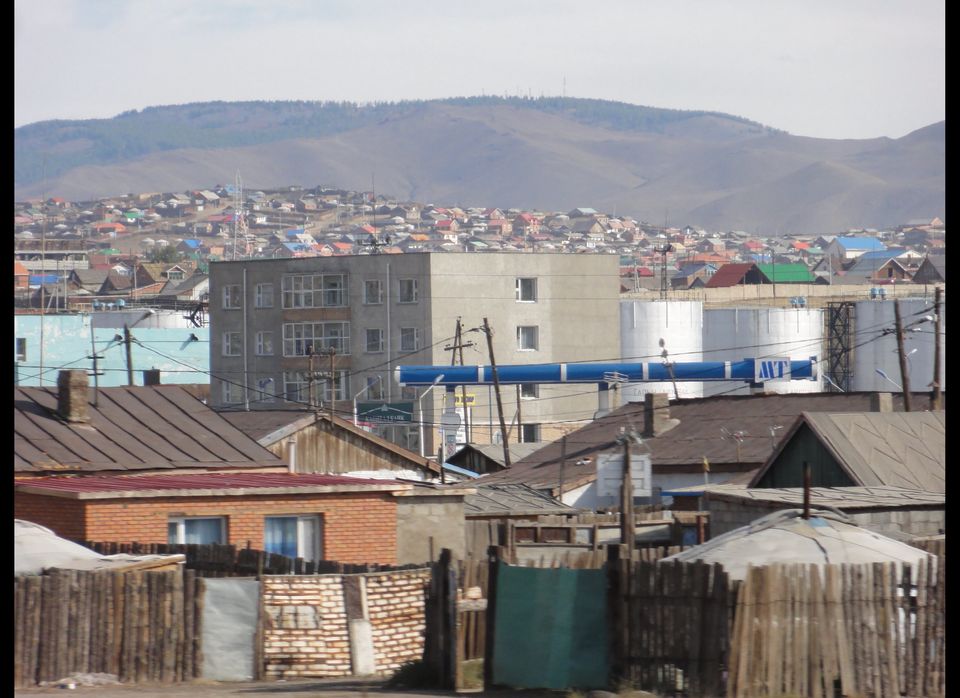The most fascinating stop on my Trans-Siberian Railroad journey across northern Asia was Mongolia, a country steeped in ancient history and the lore of Genghis Khan, a man who created a global empire. Today, Mongolia's government is committed to rapid urban development that is pushing its capital, Ulaanbaatar full speed into the 21st century.
My visit to Mongolia introduced me to two women: one a lovely urban sophisticate from Ulaanbaatar, and the other, a petite young woman, who with her husband and baby, were denizens of a rural community not too far from Ulaanbaatar. This family lived in a Ger, the traditional felt and wooden lattice one-room structure that has exemplified Mongolian life for hundreds of years.
As I exited the train in Ulaanbaatar, I was surprised by the bustle of activity that greeted us: western-dressed shoppers moving quickly about the city streets and roads flush with late model cars and trucks carrying all manner of goods, particularly construction materials. I had read in one of my guidebooks that less than twenty years ago this capital city was a sleepy town. Now, it is a completely different story. As our van moved us around the environs of the rail station, I saw construction taking place everywhere, cranes dotting the streets and a procession of pastel-colored apartment complexes perched shoulder-to-shoulder, set in a valley surrounded by four mountain ranges.
Emma, our Mongolian guide, is a resident in one of a profusion of apartments houses in this city of over one million. Tall and dark haired, she spoke perfect English and moved about the city telling us with effortless enthusiasm about Ulaanbaatar's new growth and its interest in inviting visitors to visit. With a background in the arts, she was excited to introduce us to the traditional dance and music traditions of her country. We attended a vibrant performance of traditional folk music at Ulaanbaatar's major concert hall where our little group found the music from the percussion and stringed instruments quite lyrical and imaginative.
She also escorted us to the giant city square where the hallowed contemporary Parliament Building entrance features three regal bronze sculptures of Genghis Khan and his father and brother trumpeting their importance in the timeline of Mongolian achievement. The square was surrounded by high-rise concrete and glass office buildings, huge billboards advertising a range of technology products, and a continuous flurry of movement of workers and cars moving (slowly because of monster traffic) around the area.
An escape to the country was on our agenda after a couple of days in the capital. A complete change in topography awaited us and we were excited to make another connection with the local people. This time our new acquaintance was a small family who lived about an hour outside Ulaanbaatar in a small encampment of horses, sheep, and the traditional Ger habitat. The circular residence was spotless and well appointed with Chinese-style painted wooden furniture, corrals for belongings, and enough running space for a toddler to feel comfortable scurrying about the premises. This traditional nomadic family moves about the countryside two to four times a year. The process is swift: undo the felt and lattice substructure of the Ger, wrap personal belongings and load up a truck or horse driven cart and be on your way in about an hour.
Our host presented us with bowls of fermented mare's milk (an acquired taste) and a variety of nuts and nibbles. Her husband greeted us briefly, but remained outside tending to his horses during most of our visit (I think he was a little shy.) As we gathered around a low dining table we managed to have a limited conversation with his wife due to our mutual lack of understanding of each others languages. However, body language and broad smiles are great aids in communication and it was a comfortable and pleasant visit. We left feeling we had embraced more than just a peripheral encounter with the nomadic life in Mongolia. It felt so peaceful to be out there and if anything, I hope to remember that "moment of serenity" when I battle big city life, crowds and rush hour traffic back in Chicago.
Pat Johnson
Grannies on Safari
